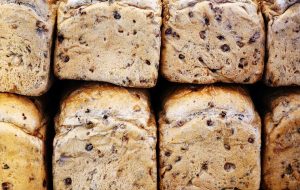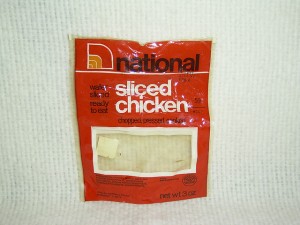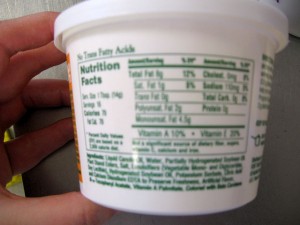If you’ve read any of our posts that mention diet, you know we harp on eating healthy just as much as anyone. A healthy diet combined with exercise is the best way to lose weight, build muscle and get into shape. You might think you’re eating healthy, reaching for the foods on the supermarket shelves labeled “low-fat,” “multi-grain” or “all-natural” but, if you’re not seeing the weight loss results you want, the roadblock could be all that “healthy” food you’re eating.
Translation: Low-Fat=High Sugar & Calories

Low and reduced-fat products usually have more sugar and as many calories as their “regular” counterparts.
The problem with eliminating ingredients from foods is that you need to replace them with something. In the case of low-fat and fat-free foods, most manufacturers use extra sugar to fill in the flavor-gap left when fat is removed or reduced. Increasing the sugar content may make the low-fat versions more palatable, but it also increases the calorie count to equal or sometimes even more than the full-fat varieties.
When you’re faced with choosing between two products that have equal calories but one has a balance of fat and sugar and the other has excessive sugar but not fat, pass up the fat-free option. According to an experiment outlined in the Daily Mail, you’ll lose more weight cutting down on sugar than by eliminating fat. Plus, a healthy diet includes both sugar and fat to help you function normally.
One other issue to keep in mind when contemplating reduced fat products is that they may eliminate or reduce healthy fats. Cooking Light points out that low-fat peanut butter, for instance, has less fat overall than regular peanut butter, but the regular variety includes monounsaturated fats that are actually good for you. The solution instead of eating low-fat peanut butter is to opt for a natural peanut butter that doesn’t have extra oils/fats added to it.
Not All Oatmeal Is Your Friend

Skip the instant oatmeal with its extra salt and sugar and opt for regular or steel cut oats with honey or fresh fruit.
You may have adopted what you believe is the healthy eating habit of having oatmeal for breakfast almost every morning. If, because of your busy schedule, you usually scarf down a bowl of the convenient instant type, that’s where your healthy diet is getting derailed. According to Prevention, instant oatmeals typically contain added sugar and sodium as flavor enhancers. The better diet-healthy move is to boil up a pot of whole or steel cut oats and enhance the flavor yourself with fresh fruit, a sprinkle of cinnamon or a drizzle of honey.
If time is a factor, mix up four or five jars of overnight oats once a week. Not only do they provide a tasty breakfast you can grab on the go, but they also incorporate the healthiest versions of oats (old-fashioned or steel-cut) with other nutritious ingredients like chia seeds, yogurt and fresh fruit. Once you understand the ratios of ingredients to make overnight oats, you can make a variety of flavors. Just to get you started, Eat This, Not That has links to over 50 delicious overnight oats recipes.
The Tall Tale of 7 Grains

Sure, it has 7 grains, but if they’re not WHOLE grains, they don’t have more to offer than any other refined grain product.
You’ve ditched the soft white bread of your youth, and now only craft sandwiches out of hearty, multi-grain bread. Unfortunately, if you don’t read labels, that 7-grain loaf of bread is probably not the healthy diet food you think it is. According to Spoon University, “multi-grain” on the label doesn’t mean that the loaf tucked inside is healthier for you than any other bread. It only indicates that more than one type of grain was used to make it. Those grains were still likely refined, so you won’t be reaping the benefits of the whole grain. That’s the key, though: look for baked goods that are whole-grain. Also, when reading labels, the first ingredient is all-important. With breads and other baked goods, if the first ingredient is bleached or unbleached wheat flour, it’s still a refined product and not 100 percent whole-grain, even if it’s “enriched.”
Let’s Talk Turkey

Packaged meats have a lot of extras that outweigh the healthy elements meat can bring to your diet.
Image by robertstinnette/Flickr
…or any other packaged lunch meat. The packaging is the problem. Additional ingredients are the price you pay for the convenience of having what’s typically considered a healthy meat already cooked, sliced, and ready to put into a sandwich or on top of a salad. Not only does packaged, sliced turkey contain an alarming amount of sodium, it also usually has artificial flavoring, preservatives and sometimes even coloring. WBUR in Boston says that researchers are now looking at artificial additives in foods as a contributing factor in obesity. Bypass the convenient but unhealthy packaged meat and roast a chicken or turkey on the weekend. Then just slice it up yourself, storing it in single-serving sizes in the freezer for a nutritious supply of protein.

Read the entire label — nutrition facts, ingredients and all — to get an accurate picture of how healthy the foods in your diet really are. Image by ilovebutter/Flickr
Of course a healthy weight loss plan is one that includes exercise, a healthy diet, and monitoring your caloric intake versus energy expenditure, but becoming a label reader is essential. Not just the big words splashed across the top of the packaging, either, but the actual nutritional information found in small print on the back. It will make all the difference in the world for your weight loss plans to finally, truly be eating healthy, and could even be a little liberating, too.
